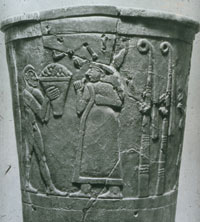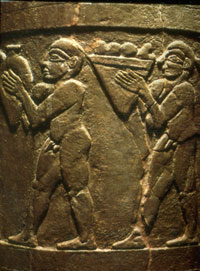Performativity of the Uruk Vase: Foregrounded scripts and collective representations
Response to Discussion Week 6: Materiality and performativity: artifacts and their performance in the social sphere
Omur Harmansah Posted: October 22, 2006. Sunday: 11:11 pm.

This brief commentary springs out of my reading of two extremely provocative articles: Jeffrey C. Alexander’s thorough discussion of social performance as “cultural pragmatics” and Zainab Bahrani’s performative reading of the Uruk (Warka) Vase of the Late Uruk Period from the Late 4th millennium Southern Mesopotamia. The two authors are presumably unaware of each other (they don’t refer to each other’s work in these two articles), it is my attempt to reconcile their views, in the hope of utilizing some of Alexander’s analytical tools on performance to take Bahrani’s admirable project of unpacking the Uruk Vase further from a performative perspective. Bahrani’s theory of performativity of the image is largely derived from performative speech act theory of J.L. Austin (How to do things with words) and especially writings of Jacques Derrida (1). It is therefore largely limited to a linguistic, discursive framework.
Whereas Alexander seems to be largely ignorant of any scholarly interest in social performance within the field of Near Eastern Studies. In fact, when he attempts to historicize the social processes through which ancient complex societies moved from ritual to theater, he uncritically subscribes to the now-outdated and heavily discredited historical paradigm of axial civilizations (see esp. Alexander 2006: 42-51, note references to Eisenstadt). The theory of axial civilizations of 1950s and 60s, mainly proposed by Shmuel N. Eisenstadt, situates a “revolutionary spirit”, historical consciousness and self-reflexivity among certain "axial" (predominantly monotheistic) civilizations (i.e. 5th-4th century Athens, Late Iron Age Israel, Zoroastrian Iran, Early Christian Europe etc) which assumes a "despotic" nature to all "pre-axial" cultures such as Mesopotamia and Ancient Egypt, where supposedly “monarchical, dictatorial, or oligarchic forms of government” had been in effect (Alexander 2006: 47). In turn, based on the work of Habermas on the emergence of the public sphere, this Judeo-Christian/Eurocentric discourse asserts that the so-called “pre-axial” civilizations lack social space, where social performances would take place to challenge the ruling authority (Alexander 2006: 51). This widespread colonialist reading the ancient non-Greek, non-Judaic world as non-complex is surprisingly still deeply embedded in academic literature as illustrated by Alexander’s recent article. Alexander, therefore would be, I think, very suspicious of Bahrani’s discussion of social drama in the Mesopotamian context of a 4th millennium BC artifact, since in his evolutionist narrative of axiality, there is indeed no place for social dramas before what he calls “Jewish drama” or “Greek theatricality” (Alexander 2006: 49). In any case, this was supposed to be a short prelude to my discussion of performativity of things, but I got caught in genealogies.
Alexander breaks down social performances into a number of analytical components: actors, observers/audience, (material) means of symbolic production, mise-en-scène and social power. The significance of his discussion for my purposes is that he does not limit the agentic core of cultural performances to human actors, their audiences and what is communicated between them, but characterizes the phenomenon as a social realm where material things, architectural spaces, collective temporalities and elements of social power are equally powerful components. He does not elaborate on them in satisfying detail but at least they are there as historical actors of performativity. Another lacking point in this tableau is the discussion of human bodies as lived corporeal entities that participate in social performances, but I guess Alexander is not ready to give in to the glories of phenomenology yet (2). However, I believe his extensive and useful discussion of constructed “authenticity” in social performances (staging) would find a perfect balance if he turned to the improvised bodily acts and gestures of human subjects, which are always there as emotionally challenging, serendipitous and full of surprises. This may have allowed him to reflect on the fluidity and flexibility of cultural performances and the resulting hybrid real-life situations and would have rescued him from being imprisoned in an otherwise rigid and unnecessarily over-structured paradigm.
In any case, Alexander characterizes social performances as a perpetual interplay between what he calls “foregrounded scripts” (Bourdieu’s dispositions) and “collective representations” (socio-symbolic background structures, Bourdieu’s habitus). His foregrounded scripts can be understood as cultural texts, such as bodily dispositions, linguistic, oral representations, pictorial representations, and material artifacts in the social sphere of cultural interaction. By their very representational nature, these representations not only reveal but also hide, often distort, but always essentialize, reduce, simplify otherwise much more complex social practices, social phenomena. Bahrani, at the beginning of her article, points out to this very problem and argues that the use of visual imagery as a straightforward historical source is very questionable, as such historicist methods privilege the content of these representations to “retrieve the historical kernel” and disregard the whole problem of representation all together (common practice in the scholarship on Near eastern art). Bahrani argues that the Uruk Vase, as an material artifact and not simply as a representation, claims its materiality in a performative way as it references its own making through the symbolic representation of the ritual activity, which itself incorporates the vase’s own image within the representation. If we can take Bahrani’s line of thought even further, the vase itself appears in the represented scene of social performance (the presentation of offerings to the Temple of Inanna on the occasion of a collective festive event) as a primary actor of the performance as a skillfully produced object of highly charged symbolism and prestige, being presented to the Temple of Inanna. From this point, I would like to claim that the Uruk Vase itself as an artifact of significance and cultural potency, and as the locus of a complex representational scheme (its carving) can be considered as a cultural text in multiple levels. The production of the pictorial representation on the Uruk Vase can be understood as performative in the sense that the represented scene with its clear hierarchization of the social world in multiple registers in a way legitimizes and preconditions the actual performance of the lived experience and naturalizes a worldview in the construction of which the intricate relations of social power are active. It brings together in the social realm the institutionalizing powers of the late Uruk society: the temple household and the king as well as the human, animal and vegetal worlds of the worldly order.
The tension between foregrounded scripts and collective representations in the context of the Uruk Vase becomes evident in Bahrani’s discussion of the proposed Sacred Marriage ritual, usually read on the Vase. Sacred Marriage Ritual, a “fixed”/”prescribed” cultural text of much later periods in Mesopotamia, is used in scholarship to explain away the represented scene on the Vase. In contrast to such a fundamental methodological mistake of egregious anachronism, Bahrani’s performative reading of the scene correctly leans towards an understanding of the habitus of social performance in early Mesopotamia rather than being fixated on fixed scripts such as Sacred Marriage.
Finally, social complexity in archaeology is a thorny topic for the post-structuralists and post-processualists since it is usually seen as one of the favorite discursive paradigms of processualism and their evolutionary schemes (3). The Uruk Vase, as Bahrani points out, was produced towards the end of the Fourth Millennium BC, precisely the spatio-temporal context which is usually associated with increasing social complexity, appearance of urbanization and monumental architectural complexes, formation of a hierarchized settlement system, invention of cuneiform writing, adoption of new tools for exchange and administration such as cylinder seals, etc. In one way, it is not necessary to see this as an evolutionary mono-directional phenomenon but a product of a series of complex and heterogeneous historical processes: particular historical circumstances, geo-environmental peculiarities, cultural achievements, socio-economic serendipidity. It is however important to note that the Uruk Vase needs to be considered in the context of such opening up of social space, freshly in the Southern Mesopotamian landscapes in the context of ceremonial centers, particularly at Uruk and Nippur. The powerful performativity of the object may then be associated with its central role in the highly contested public sphere of politico-religious spectacles of its day. Through its representational scheme, the Uruk Vase narrativizes and spatializes an important collective event, locating it at the predominant socio-economic institution in town: Temple of Inanna: and allows its makers, the historical actors to have access to this contested ground of social power.
(1) See Bahrani 2002: 20, note 13 and 14, see also Brown 2000: 29f.
(2) In fact, in the index of the book Social Performance, one does not find a single reference to Merleau-Ponty, which is quite telling about the theoretical reservations of this study, there is an emerging resistance to phenomenology in several fields these days.
(3) For a critique, see Wengrow 2001.
Works cited
Alexander, Jeffrey C.; 2006. “Cultural pragmatics: social performance between ritual and strategy,” in Social performance: symbolic action, cultural pragmatics, and ritual. Cambridge: Cambridge University Press, 29-90.
Bahrani, Zainab; 2002. “Performativity and the image: narrative, representation and the Uruk vase,” in Leaving no stones unturned: essays on the Ancient Near East and Egypt in honor of Donald P. Hansen. E. Ehrenberg (ed.). Winona Lake, Indiana: Eisenbrauns, 2002: pages 15-22.
Brown, Michael B.; 2000. Closet Space: Geographies of Metaphor from the Body to the Globe, London and New York: Routledge.
Wengrow, David; 2001. “The evolution of simplicity: aesthetic labour and social change in the Neolithic Near East,” World Archaeology 33: 168-188.


